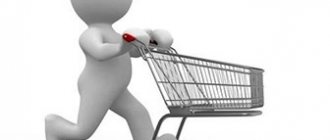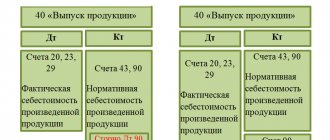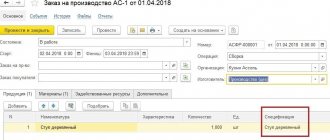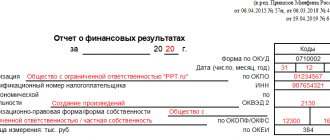Concept and types of trade
Trade is a separate branch of the economy associated with the process of transferring inventory, initially purchased for subsequent resale, for a fee from the seller to the buyer and includes a set of specific operations performed in this case.
There are 2 types of trade: wholesale and retail.
Wholesale trade is the transfer of goods and materials for a fee from the manufacturer (seller) to another seller for subsequent retail sale. Carried out in large quantities, usually at a lower price than retail.
Retail trade - single (piece) transfer of goods and materials for a fee to the end consumer.
Accounting in trade, retail and wholesale, differs both in its legislative approach and in the algorithm for reflecting business transactions. Let's look at these differences in more detail.
Features of accounting in wholesale trade
Accounting in wholesale trade includes recording the facts of receipt, internal movement of goods and materials and final sale to the buyer for subsequent resale.
Receipt of goods and materials
Receipt of inventory items is recorded by the following records:
- Dt 41 Kt 60 - receipt of goods and materials;
- Dt 19 Kt 60 - input VAT is allocated.
It is accompanied by a delivery note in the TORG-12 form and an invoice.
According to PBU 5/01 (approved by order of the Ministry of Finance of Russia dated 06/09/2001 No. 44n), all direct costs associated with the purchase of inventory and materials must be included in their cost. Direct costs include:
- delivery;
- customs duties;
- mediation, information and consulting services;
- non-refundable taxes;
- insurance, etc.
Such expenses are reflected by posting: Dt 41 Kt 60.
IMPORTANT! Organizations that maintain simplified accounting can take into account direct costs associated with the purchase of inventory items as part of the costs of ordinary activities, provided that there are no significant balances in warehouses (clauses 13.1–13.3 of PBU 5/01).
Read about which companies have the right to use simplified accounting methods here.
Internal movement of goods and materials and other costs associated with preparation for sale
After receiving the goods at the warehouse, they can be moved to other divisions of the company. In this case, the costs of delivery between departments, storage and other similar costs are taken into account as part of expenses for ordinary activities. There may also be other costs associated with the sale (packaging, advertising).
These operations carried out with the involvement of third parties are reflected in accounting transactions:
- Dt 44 Kt 60 - services of third-party organizations (IP) are reflected;
- Dt 19 Kt 60 - input VAT is allocated.
These operations can also be carried out in-house. Then this will be expressed by postings:
Dt 44 Kt 70 (69, 10, 02, 76).
The last of the above entries also accrues general expenses associated with the maintenance of the management apparatus, retail and warehouse space, and own transport.
Sales of goods and materials
The sale of wholesale goods is usually carried out in large quantities to a specific buyer.
Wiring block:
- Dt 62 Kt 90.1 - sale of goods and materials to the buyer;
- Dt 90.3 Kt 68 - allocated VAT on sales;
- Dt 90.2 Kt 41 - write-off of sold inventory items at actual cost;
- Dt 90.2 Kt 44 – write-off of sales expenses.
Receipt of payment (and prepayment) for goods sold in bulk is usually carried out by non-cash means, which is reflected by the posting:
Dt 51 (52) Kt 62.
There are several cases when implementation needs to be taken into account using account 45. ConsultantPlus experts spoke about them. Get trial access to the system for free and go to the Ready-made solution.
Structure and composition of costs of a trading enterprise
Definition 1
The costs of a trading enterprise are all the expenses incurred by the organization that are associated with bringing the goods from the manufacturer to the consumer.
The main feature of the costs of a trading organization is that they are a broader concept than distribution costs. In addition to distribution costs, the costs of a trade organization include expenses for the purchase of goods, taxes paid from the financial results of operations, and other expenses.
The generated costs of a trading enterprise make it possible to determine the lowest threshold of prices for selling goods. Selling costs occupy a special place in the accounting of trading organizations.
Finished works on a similar topic
- Course work Features of cost accounting in trade organizations 430 rub.
- Abstract Features of cost accounting in trade organizations 240 rub.
- Test work Features of cost accounting in trade organizations 230 rub.
Receive completed work or specialist advice on your educational project Find out the cost
The most common sales expenses in trade organizations are the following (Fig. 1):
Figure 1. Expenses of trade organizations
All costs of trading organizations can be presented as:
- one-time;
- current.
One-time costs, most often, are investments in the development of the enterprise (opening new stores, developing a retail or wholesale network, dealer network, etc.)
Current costs are fixed distribution costs (usually for the same expense items).
Specifics of accounting in retail trade
Accounting in retail trade is somewhat different from accounting for wholesale goods. This is due not only to the fact that sales are carried out in small batches or individually, but also to the predominance of cash payments.
Accounting for receipt of goods and materials
Retail organizations have the right to keep records of inventory items both at purchase prices and at sales prices with a separate accounting of markups (clause 13 of PBU 5/01).
IMPORTANT! The chosen accounting option should be recorded in the accounting policy.
For information on how accounting policies are formed, read the article “How to draw up an organization’s accounting policies (2020)?” .
If the store has accounting programs and special equipment, then records are kept for each type of inventory, and the program automatically writes off the cost of inventory at purchase prices (that is, quantitative and total accounting is maintained).
Well, for small shops and retail outlets that are not equipped with a software product, it is more convenient to keep records at selling prices, since this method is less expensive.
In this case, the markup is reflected on account 42 at the time of receipt of the goods.
Let's consider how transactions will differ when goods are received depending on the selected accounting price method.
| Accounting type | ||||
| At purchase prices | Content | At selling prices | ||
| Dt | CT | Dt | CT | |
| 41 | 60 | The goods have arrived | 41 | 60 |
| 19 | 60 | VAT allocated | 19 | 60 |
| Extra charge taken into account | 41 | 42 | ||
The entire amount of cash proceeds received is collected per day and recorded with the entry: Dt 50 Kt 90.1 - receipt of proceeds to the cash desk..
Sales accounting
The entire amount of revenue received is collected per day and in account 90.1 “Revenue” and is recorded as follows: Dt 50 Kt 90.1 - receipt of revenue to the cash desk.
Many stores install payment terminals for paying customers using bank cards. This type of settlement is called acquiring and is recorded by posting: Dt 51 (57) Kt 90.1.
After registering the revenue, it is necessary to show the disposal of the goods. This fact is reflected by the entry: Dt 90.2 Kt 41.
Since inventory items are listed on account 41 at selling prices, it turns out that the amount of revenue and the amount of write-off of goods are equal, so it is necessary to additionally take into account the sold margin. This is done by wiring: Dt 90.2 Kt 42 (reversible). The realized markup is the gross income of the business and is called the realized overlay.
Let's look at the differences in postings depending on the chosen price accounting method.
| Accounting type | ||||
| At purchase prices | Content | At selling prices | ||
| Dt | CT | Dt | CT | |
| 50 (51, 57) | 90.1 | Revenue received | 50 (51, 57) | 90.1 |
| 90.3 | 68 | VAT charged on revenue | 90.3 | 68 |
| 90.2 | 41 | Cost of goods sold written off | 90.2 | 41 |
| Realized markup written off | 90.2 | 42 (reversible) | ||
According to clause 12 of the Methodological Recommendations for accounting and registration of operations for the receipt, storage and release of goods in trade organizations (letter of Roskomtorg dated July 10, 1996 No. 1-794/32-5), the realized overlay is determined by calculation when accounting for inventory items at selling prices.
Calculation is carried out in 4 ways:
- Based on total trade turnover.
- Assortment of commodity turnover.
- Average percentage
- Assortment of remaining inventory items.
The procedure and calculation formulas for each method can be found in the material “How to correctly calculate gross income?”
The selected calculation option must be reflected in the company's accounting policies.
The most convenient and frequently used method is the average percentage calculation.
The implemented overlay is calculated, usually at the end of the month, using the following formulas:
Mon = (Nstart + Npost – Nset) / (Tob + Remaining) × 100%,
Where:
Mon—percentage of realized margin;
Nnach - opening account balance 42;
Npost - the amount of the received markup (credit turnover of account 42);
Nvyb - the amount of discounts, markdowns and other operations that reverse account 42;
Tob - revenue;
Residual — balance of inventory items at the end of the billing period.
Рн = Mon × Tob,
Where:
Рн — implemented overlay.
The amount received is recorded as follows: Dt 90.2 Kt 42 (reversal).
For each sale, the seller is required to enter a cash receipt. This document reflects the amount of VAT, and it eliminates the need to issue an invoice (clause 7 of Article 168 of the Tax Code of the Russian Federation). And a cash register report for the shift is entered into the purchase book.
This rule applies exclusively to cash payments. If the money is credited to the current account, the seller is obliged to draw up an invoice within 5 days (clause 3 of Article 168 of the Tax Code of the Russian Federation).
You will find more nuances regarding VAT in retail trade in the Ready-made solution from ConsultantPlus, having received free trial access to the system.
Features of cost accounting in trade organizations
Content:
Introduction…………………………………………………………………………………3
1. Theoretical foundations of cost accounting in a trade organization…………..4
1.1 The essence of the concepts costs, expenses, expenses…………………….….4
1.2 Regulatory regulation of cost accounting in a trade organization....7
2. Cost accounting in a trading organization……………………………………15
2.1 Accounting for costs when purchasing goods………………………………….15
2.2 Cost accounting when purchasing fixed assets………………………23
Conclusion………………………………………………………………………………27
List of used literature……………………………………………………28
Introduction
Any commercial organization, in the course of its activities, incurs certain costs. For example, this includes the purchase of goods and services.
The main objectives of cost accounting in trade organization are to ensure timely, complete and reliable reflection of costs and control over the use of financial resources.
When accounting for costs, a trade organization is obliged to ensure their synthetic and analytical accounting.
The purpose of this course work is to study the features of cost accounting in trade organizations.
The objectives are as follows: to study the essence of costs, to consider the legal acts governing cost accounting in an organization, to use examples to consider the operations that are carried out in the accounting department of organizations in the process of cost accounting.
1. Theoretical foundations of cost accounting in a trading organization.
1.1 The essence of the concepts of costs, expenses, expenses.
Expenses
Costs are the cost of resources used for a specific purpose. There are three points to highlight in this definition:
1) costs are determined by the amount of resources used (material, labor, financial);
2) the amount of resources used must be presented in monetary terms to ensure comparison of various resources;
3) the concept of costs must necessarily be correlated with specific goals and objectives. Such tasks can be production of products, performance of work, provision of services, making capital investments, functioning of a department, service, etc. Without specifying a goal, the concept of costs becomes vague and means nothing.
For a trading organization, the concept of costs means the acquisition of goods and fixed assets. Costs for the acquisition of goods in a trade organization are recorded on the debit of account 41 goods, and costs of acquisition of fixed assets on the debit of account 08 investments in non-current assets.
The concept of “expenses” should be distinguished from the concept of “costs”.
Expenses
In domestic practice, the concept of “expenses” is set out in PBU 10/99 “Expenses of an organization” and in the Tax Code of the Russian Federation.
According to PBU 10/99, an organization’s expenses are recognized as a decrease in economic benefits as a result of the disposal of assets and the emergence of liabilities, leading to a decrease in the organization’s capital, with the exception of a decrease in contributions by decision of property owners.
The expenses of the organization, depending on their nature, conditions of implementation and areas of activity of the organization, are divided into:
expenses for ordinary activities;
other expenses.
Expenses for ordinary activities for a trading organization are expenses associated with the sale of products, the acquisition and sale of goods. Expenses for ordinary activities are also considered to be reimbursement of the cost of fixed assets, intangible assets and other depreciable assets, carried out in the form of depreciation charges.
Expenses for ordinary activities are accepted for accounting in an amount calculated in monetary terms equal to the amount of payment in cash and other forms or the amount of accounts payable.
When forming expenses for ordinary activities, their grouping should be ensured by the following elements:
material costs;
labor costs;
contributions for social needs;
depreciation;
other costs.
Other expenses are subject to credit to the organization's profit and loss account.
Distribution costs
A feature of cost accounting in trade organizations is that the cost of goods is not determined. At the same time, in these organizations, goods are subject to accounting at acquisition cost, when in addition to the purchase price of goods, this cost includes transport and similar expenses.
In the sphere of circulation, trade organizations incur expenses associated with the implementation of their activities in order to bring goods manufactured by the manufacturer to the consumer (buyer). Trade circulation costs arise.
“Distribution costs are the consumed material and labor resources in the process of supply and sales activities for the delivery, processing and packaging of finished products, as well as for the purchase and sale of goods”
Methodological recommendations for cost accounting define the following items of distribution costs for a trading organization:
1. Transport costs;
2. Labor costs;
3. Contributions for social needs;
4. Expenses for rent and maintenance of buildings, structures, premises, equipment and inventory;
5. Expenses for repairs of fixed assets;
6. Wear and tear of sanitary and special clothing, table linen, dishes, cutlery, and other low-value and wearable items;
7. Expenses for fuel, gas, electricity for production needs;
8. Expenses for storage, part-time work, sorting and packaging of goods;
9. Advertising expenses;
10. Costs of paying interest for using the loan;
11. Loss of goods and process waste;
12. Costs for packaging;
13. Depreciation of fixed assets;
14. Other expenses.
1.2 Regulatory regulation of cost accounting in a trade organization.
There are 4 levels of regulatory regulation of cost accounting in a trade organization
Level 1 – federal laws
Regulatory legal acts include: Federal Law of November 21, 1996 N 129-FZ “On Accounting” and regulatory legal acts of the Ministry of Finance of Russia. Acts of the Ministry of Finance of Russia acquire the significance of normative legal ones after their registration by the Ministry of Justice of Russia and publication in the Rossiyskaya Gazeta, as well as in the Bulletin of normative acts of federal executive bodies of the publishing house "Legal Literature" of the Administration of the President of the Russian Federation.
Level 2 – PBU 5/01 and PBU 6/01
General provisions of PBU 5/01
For the purposes of these Regulations, the following assets are accepted for accounting as inventories:
used as raw materials, materials, etc. in the production of products intended for sale (performance of work, provision of services);
intended for sale;
used for the management needs of the organization.
Valuation of inventories
Inventories are accepted for accounting at actual cost.
The actual cost of inventories purchased for a fee is the amount of the organization's actual costs for the acquisition, with the exception of value added tax and other refundable taxes (except for cases provided for by the legislation of the Russian Federation).
The actual costs of purchasing inventories include:
amounts paid in accordance with the agreement to the supplier (seller);
amounts paid to organizations for information and consulting services related to the acquisition of inventories;
customs duties;
non-refundable taxes paid in connection with the acquisition of a unit of inventory;
remunerations paid to the intermediary organization through which inventories were acquired;
costs for the procurement and delivery of inventories to the place of their use, including insurance costs. These costs include, in particular, costs for the procurement and delivery of inventories; costs of maintaining the procurement and warehouse division of the organization, costs of transport services for the delivery of inventories to the place of their use, if they are not included in the price of inventories established by the contract; accrued interest on loans provided by suppliers (commercial loan); interest on borrowed funds accrued before the inventory was accepted for accounting, if it was raised for the acquisition of these inventories;
costs of bringing inventories to a state in which they are suitable for use for the intended purposes. These costs include the organization’s costs of processing, sorting, packaging and improving the technical characteristics of received stocks, not related to the production of products, performance of work and provision of services;
other costs directly related to the acquisition of inventories.
General and other similar expenses are not included in the actual costs of purchasing inventories, except when they are directly related to the acquisition of inventories.
General provisions of PBU 6/01
This Regulation establishes the rules for the formation in accounting of information about the organization’s fixed assets.
An asset is accepted by an organization for accounting as fixed assets if the following conditions are simultaneously met:
a) the object is intended for use in the production of products, when performing work or providing services, for the management needs of the organization, or to be provided by the organization for a fee for temporary possession and use or for temporary use;
b) the object is intended to be used for a long time, i.e.
a period exceeding 12 months or the normal operating cycle if it exceeds 12 months;
c) the organization does not intend the subsequent resale of this object;
d) the object is capable of bringing economic benefits (income) to the organization in the future.
A non-profit organization accepts an object for accounting as fixed assets if it is intended for use in activities aimed at achieving the goals of creating this
a non-profit organization (including in business activities carried out in accordance with the legislation of the Russian Federation), for the management needs of a non-profit organization, and also if the conditions established in subparagraphs “b” and “c” of this paragraph are met.
The useful life is the period during which the use of an item of fixed assets brings economic benefits (income) to the organization. For certain groups of fixed assets, the useful life is determined based on the quantity of products (volume of work in physical terms) expected to be received as a result of the use of this object.
Fixed assets include: buildings, structures, working and power machines and equipment, measuring and control instruments and devices, computer equipment, vehicles, tools, production and household equipment and supplies, working, productive and breeding livestock, perennial plantings, on-farm roads and other relevant objects.
Valuation of fixed assets
Fixed assets are accepted for accounting at their original cost.
The initial cost of fixed assets acquired for a fee is recognized as the amount of the organization's actual costs for acquisition, construction and production, with the exception of value added tax and other refundable taxes (except for cases provided for by the legislation of the Russian Federation).
Typical postings in trade organizations
Example 1
LLC "Versal" is engaged in wholesale trade in cement.
On February 1, the goods arrived - 2,835 bags (50 kg each). Price — 187 rub. for a unit. A total of 530,145 rubles. (including VAT RUB 88,357.50).
Direct costs were: delivery - 53,350 rubles. (including VAT RUB 8,961.67).
Cement was sold in the amount of 1,847 pieces. in the amount of 561,750 rubles. (including VAT RUB 93,625.00). The costs of delivering goods and materials to the buyer under the contract are at the expense of the seller in the amount of 43,467 rubles. (including VAT RUB 7,244.50).
| Dt | CT | Amount, rub. | Calculation | Detailing |
| 41 | 60 | 441 787,50 | 530 145 – 88 357,50 | The goods have arrived |
| 19 | 60 | 88 357,50 | VAT allocated | |
| 41 | 60 | 44 388,33 | 53 350 – 8 961,67 | Delivery services have arrived |
| 19 | 60 | 8 961,67 | VAT allocated | |
| 62 | 90.1 | 561 750 | Sales of goods | |
| 90.3 | 68 | 93 625,00 | VAT on sales | |
| 90.2 | 41 | 316 743,12 | (441 787,50 + 44 388,33) / 2835 × 1847 | The cost of cement is written off |
| 44 | 60 | 36 222,50 | 43 467 – 7 244,50 | Delivery costs to the buyer are taken into account |
| 19 | 60 | 7 244,50 | Input VAT on delivery services to the buyer | |
| 90.2 | 44 | 36 222,50 | Write-off to the cost of delivery services to the buyer |
The cost of cement sold was RUB 352,956.62. (316,743.12 + 36,222.50).
The financial result of these operations is visible when forming SALT for account 90. Let's consider it in more detail.
| Check | Name | Opening balance | Turnover for the period, rub. | Final balance, rub. | |||
| Dt | CT | Dt | CT | Dt | CT | ||
| 90.1 | Revenue | 561 750,00 | 561 750,00 | ||||
| 90.2 | Cost price | 352 956,62 | 352 956,62 | ||||
| 90.3 | VAT | 93 625,00 | 93 625,00 | ||||
| 90.9 | Profit/loss | 115 168,38 | 115 168,38 | ||||
Thus, the gross income of Versailles LLC for February 2021 amounted to 115,168.38 rubles.
Example 2
Demetra LLC is engaged in retail trade in food products. The company applies a special UTII regime and does not pay VAT.
The stores are not equipped with special programs, and records are kept at sales prices (total). Every ten days, store managers submit commodity and cash reports (hereinafter referred to as TAR) to the accounting department with the attachment of primary documents.
For the 1st decade of July, store No. 1 passed the TAR with the following data:
| Operation | Amount with extra charge, rub. | Cost, rub. | Markup, rub. |
| Balance as of June 30 | 466 773,57 | 133 587,33 | |
| Coming | 589 793,10 | 453 687 | 136 106,10 |
| Total consumption: | 510 672,60 | ||
| including cash revenue | 387 336,77 | ||
| including non-cash revenue | 123 335,83 | ||
| Balance as of 10.07 | 545 894,07 |
Postings:
| Dt | CT | Amount, rub. | Detailing | Note |
| 41 | 60 | 453 687 | Receipt of goods and materials | To be entered for each counterparty |
| 41 | 42 | 136 106,10 | Extra charge | |
| 50 | 90.1 | 387 336,77 | Proceeds received at the cash register | |
| 51 | 90.1 | 123 335,84 | Receipt of proceeds to the account | |
| 90.2 | 41 | 510 672,60 | The cost of inventory items is written off at selling prices |
Calculation of the implemented overlay:
- (133 587,33 + 136 106,10) / (510 672,60 + 545 894,07) × 100% = 25,52%;
- 510,672.60 × 25.52% = RUB 130,323.65
That is, gross income is recorded by reversing entry Dt 90.2 Kt 42 in the amount of RUB 130,323.65.
Results
Accounting in trade organizations depends on the type of trade: wholesale or retail. At the same time, in retail outlets equipped with a special software product, accounting is carried out automatically at the cost of each unit of goods, that is, quantitatively.
If the point is not automated, then in retail it is allowed to keep records only in total terms at retail prices with a designated markup. In this case, the financial result of the company’s work is determined by calculation.
The chosen accounting option is necessarily recorded in the accounting policy.
Sources:
- Tax Code of the Russian Federation
- Order of the Ministry of Finance of Russia dated 06/09/2001 No. 44n
- Methodological recommendations for accounting and registration of operations of receipt, storage and release of goods in trade organizations
You can find more complete information on the topic in ConsultantPlus. Free trial access to the system for 2 days.
Selling and administrative expenses
When choosing a method for recognizing and dividing commercial costs and management enterprises, they must be guided by the norms of PBU 10/99 (clause). Organizations establish the procedure for recognizing commercial and administrative expenses independently and record it in their accounting policies. When reflecting the complex of costs incurred, account 44 is used in terms of sales costs, and account 26 is used in terms of management type costs.
What is considered a business expense and what should be recorded as management costs? The former are characterized by interaction with the production and sales segments of the enterprise, the latter are associated with the maintenance of general purpose property. Business expenses include costs for:
- packaging of finished products intended for sale;
- delivery of marketable products to customers’ warehouse facilities;
- conducting advertising campaigns and marketing research.
What is included in the commercial expenses of industrial enterprises in addition to the following:
- maintenance of warehouse premises and equipment at points of sale of goods;
- accrued wages to hired sellers;
- entertainment expenses;
- reimbursement of travel expenses for employees from the sales department.
The composition of commercial expenses of trading firms is supplemented by wages for hired personnel in sales departments, rental of sales floors and premises for storing goods, depreciation charges for various types of assets and payments for housing and communal services.
In agricultural activities, business expenses include maintenance and service costs:
- procurement units;
- reception points;
- facilities built for raising livestock or poultry.
In accounting, commercial expenses are costs accumulated in account 44 and subject to write-off in the amount and frequency approved by local regulations. The managerial type of costs forms the cost of services of security organizations, the price of using the Internet and communications, and the amount of bills for housing and communal services.








